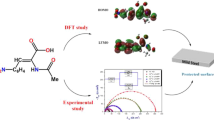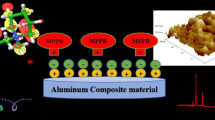Abstract
The demand for corrosion inhibitors with low toxicity has increased in the last years in a wide range of sectors. Our study presents the synthesis, X-ray structure, thermal and kinetic investigation of ethylethanolammonium 4-nitrobenzoate (EEA4NB) as corrosion inhibitor for iron in 3% NaCl solution. Proton transfer and hydrogen bonding in the organic salt were elucidated and confirmed by infrared spectroscopy and single-crystal X-ray diffraction. Simultaneous TGA–DTA and heat flow analysis were used to study the thermal and kinetic behavior of EEA4NB. The results provided useful information about thermal stability and thermal decomposition. The non-isothermal kinetic parameters were estimated by using three different kinetic methods. Electrochemical corrosion measurements show corrosion inhibitor efficiency of EEA4NB for iron in 3% NaCl solution higher than 92% and a decrease of corrosion current and corrosion rate as a result of adsorption of EEA4NB molecules at the metal/solution interface.









Similar content being viewed by others
Change history
11 June 2018
The author group was published incompletely in the original publication. The complete author group is given in this erratum. The original article has been corrected.
References
Khaled KF. Experimental, density function theory calculations and molecular dynamics simulations to investigate the adsorption of some thiourea derivatives on iron surface in nitric acid solutions. Appl Surf Sci. 2010;256:6753–63.
Li C, Li L, Wang C. Study of the inhibitive effect of mixed self-assembled monolayers on copper with SECM. Electrochim Acta. 2014;115:531–6.
Behpour M, Ghoreishi SM, Soltani N, Salavati-Niasari M, Hamadanian M, Gandomi A. Electrochemical and theoretical investigation on the corrosion inhibition of mild steel by thiosalicylaldehyde derivatives in hydrochloric acid solution. Corros Sci. 2008;50:2172–81.
Behpour M, Ghoreishi SM, Soltani N, Salavati-Niasari M. The inhibitive effect of some bis-N, S-bidentate Schiff bases on corrosion behaviour of 304 stainless steel in hydrochloric acid solution. Corros Sci. 2009;51:1073–82.
Behpour M, Ghoreishi SM, Mohammadi N, Soltani N, Salavati-Niasari M. Investigation of some Schiff base compounds containing disulfide bond as HCl corrosion inhibitors for mild steel. Corros Sci. 2010;52:4046–57.
Behpour M, Ghoreishi SM, Gandomi-Niasar A, Soltani N, Salavati-Niasari M. The inhibition of mild steel corrosion in hydrochloric acid media by two Schiff base compounds. J Mater Sci. 2009;44:2444–53.
Behpour M, Ghoreishi SM, Salavati-Niasari M, Mohammadi N. Corrosion protection of copper by TiO2 nanoparticles and SN Schiff base coating. J Nanostruct. 2012;2:317–26.
Behpour M, Ghoreishi SM, Salavati-Niasari M, Ebrahimi B. Evaluating two new synthesized S-N Schiff bases on the corrosion of copper in 15% hydrochloric acid. Mater Chem Phys. 2008;107:153–7.
Eddy NO, Momoh-Yahaya H, Oguzie EE. Theoretical and experimental studies on the corrosion inhibition potentials of some purines for aluminium in 0.1 M HCl. J Adv Res. 2015;6:203–17.
Vaysburd AM, Emmons PH. Corrosion inhibitors and other protective systems in concrete repair: concepts or misconcepts. Cem Concr Compos. 2004;26:255–63.
Söylev TA, Richardson MG. Corrosion inhibitors for steel in concrete: state-of-the-art report. Constr Build Mater. 2008;22:609–22.
Gaidis JM. Chemistry of corrosion inhibitors. Cem Concr Compos. 2004;26:181–9.
Liu JZ, Zhao D, Cai JS, Shi L, Liu JP. Arylaminoalcohols as corrosion inhibitors for carbon steel in chloride-contaminated simulated concrete pore solution. Int J Electochem Sci. 2016;11:1135–51.
Song HW, Saraswathy V. Corrosion monitoring of reinforced concrete structures—a review. Int J Electochem Sci. 2007;2:1–28.
Ormellese M, Lazzari L, Goidanich S, Fumagilli G, Brenna A. A study of organic substances as inhibitors for chloride-induced corrosion in concrete. Corros Sci. 2009;51:2959–68.
Chicu SA, Herrmann K, Berking S. An approach to calculate the toxicity of simple organic molecules on the basis of QSAR analysis in H. echinata. Quant Struct Act Relatsh. 2000;19:227–36.
Chicu SA, Grozav M, Kurunczi L, Crisan M. SAR for amine salts of carboxylic acids to Hydractinia echinata test system. Rev Chim. 2008;59:582–7.
Gibellini F, Smith TK. The Kennedy pathway-de novo synthesis of phosphatidylethanolamine and phosphatidylcholine. IUBMB Life. 2010;62:414–28.
Crisan M, Halip L, Bourosh P, Chicu SA, Chumakov Y. Synthesis, structure and toxicity evaluation of ethanolamine nitro/chloronitrobenzoates: a combined experimental and theoretical study. Chem Cent J. 2017;11:129–38.
Sibel Z. The effects of benzoic acid in chloride solutions on the corrosion of iron and aluminum. Turk J Chem. 2002;26:403–8.
Amiery AAA, Kassim FAB, Kadhum AAH, Mohamad AB. Synthesis and characterization of a novel eco-friendly corrosion inhibition for mild steel in 1 M hydrochloric acid. Sci Rep. 2016;6:19890.
Rani ABE, Basu BBJ. Green inhibitors for corrosion protection of metals and alloys: an overview. Int J Corros. 2012;2012:Article ID 380217.
Vyazovkin S. Model-free kinetics-staying free of multiplying entities without necessity. J Therm Anal Calorim. 2006;83:45–51.
Friedman HL. Kinetics of thermal degradation of char-forming plastics from thermogravimetry. Application to a phenolic plastic. J Polym Sci. 1965;6C:183–95.
Flynn JH, Wall LA. A quick, direct method for the determination of activation energy from thermogravimetric data. Polym Lett. 1966;4:323–8.
Ozawa T. A new method of analyzing thermogravimetric data. Bull Chem Soc Jpn. 1965;38:1881–6.
Crisan M, Vlase G, Szerb EI, Vlase T. Thermal and kinetics studies of primary, secondary and tertiary alkanolammonium salts of 4-nitrobenzoic acid. J Therm Anal Calorim. 2018. https://doi.org/10.1007/s10973-018-6975-7.
Sempere J, Nomen R, Serra R, Soravilla J. The NPK method: an innovative approach for kinetic analysis of data from thermal analysis and calorimetry. Thermochim Acta. 2002;388:407–14.
Serra R, Sempere J, Nomen R. A new method for the kinetic study of thermoanalytical data: the non-parametric kinetics method. Thermochim Acta. 1998;316:37–45.
Vlase T, Vlase G, Doca N, Bolcu C. Processing of non-isothermal TG data. Comparative kinetic analysis with NPK method. J Therm Anal Calorim. 2005;80:59–64.
Chumakov YM, Simonov Y, Grozav M, Crisan ME, Bocelli G, Yakovenko AA, Lyubetsky D. Hydrogen-bonding network in the organic salts of 4-nitrobenzoic acid. Cent Eur J Chem. 2006;4:458–75.
Crisan ME, Bourosh P, Chumakov YM, Petric M, Ilia G. Supramolecular assembly and Ab initio quantum chemical calculations of 2-hydroxyethylammonium salts of para-substituted benzoic acids. Cryst Growth Des. 2013;13:143–54.
Crisan ME, Bourosh P, Maffei ME, Forni A, Pieraccini S, Sironi M, Chumakov YM. Synthesis, crystal structure and biological activity of 2-hydroxyethylammonium salt of p-aminobenzoic acid. PLoS ONE. 2014;9:e101892.
Dinnappa RK, Mayanna SM. Benzoic acid and substituted benzoic acids as interfacial corrosion inhibitors for copper in HClO4. J Appl Electrochem. 1981;11:111–6.
Sheldrick GM. A short history of SHELX. Acta Cryst. 2008;A64:112–22.
Sheldrick GM. Crystal structure refinement with SHELXL. Acta Cryst. 2015;C71:3–8.
Macrae CF, Edgington PR, McCabe P, Pidcock E, Shields GP, Taylor R, Towler M, van de Streek J. Mercury: visualization and analysis of crystal structures. J Appl Crystallogr. 2006;39:453–7.
Hu XG, Zhang HM, Tu B, Fang YY, Jin ZM. [2-Hydroxy-1,1-bis(hydroxymethyl)ethyl]-bis(2-hydroxyethyl)ammonium 4-nitrobenzoate monohydrate. Acta Cryst. 2006;E62:o1276–8.
Broker GA, Tiekink ERT. Bis[ethyl(2-hydroxyethyl)azanium] 2,2′-disulfanediyldibenzoate. Acta Cryst. 2010;E66:o705.
Pavia DL, Lampman GM, Kriz GS. Introduction to spectroscopy: a guide for students of organic chemistry. 3rd ed. Andover: Tomson Learning; 2001.
Silverstein RM, Webster FX. Spectrometric identification of organic compounds. 7th ed. Hoboken: Wiley; 1998.
Birta N, Doca N, Vlase G, Vlase T. Kinetic of sorbitol decomposition under non-isothermal conditions. J Therm Anal Calorim. 2008;92:635–8.
Vlase T, Vlase G, Birta N, Doca N. Comparative results of kinetic data obtained with different methods for complex decomposition step. J Therm Anal Calorim. 2007;88:631–5.
Vlase G, Bolcu C, Modra D, Budiul MM, Ledeţi I, Albu P, Vlase T. Thermal behavior of phthalic anhydride-based polyesters. J Therm Anal Calorim. 2016;126:287–92.
Ceban I, Blajovan R, Vlase G, Albu P, Koppandi O, Vlase T. Thermoanalytical measurements conducted on repaglinide to estimate the kinetic triplet followed by compatibility studies between the antidiabetic agent and various excipients. J Therm Anal Calorim. 2016;126:195–204.
Patrutescu C, Vlase G, Turcus V, Ardelean D, Vlase T, Albu P. TG/DTG/DTA data used for determining the kinetic parameters of the thermal degradation process of an immunosuppressive agent: mycophenolate mofetil. J Therm Anal Calorim. 2015;121(3):983–8.
Wall ME. Singular value decomposition and principal component analysis. In: Berrar DP, Dubitzky W, Granzow M, editors. A practical approach to microarray data analysis, vol. 9. Norwell: Kluwer-NorwelL. 2003. p. 91–109. LANL LA-UR-02.
Śestak J, Berggren G. Study of the kinetics of the mechanism of solid-state reactions at increasing temperatures. Thermochim Acta. 1971;3:1–12.
Acknowledgements
This work was developed through a bilateral project between Romania and Moldova, CCCDI-UEFISCDI, PN3-P3-217/24BM/19.09.2016 (Romania), 16.80013.5007.04/RO (Moldova) and Romanian Academy Program No. 2 of Institute of Chemistry Timisoara.
Author information
Authors and Affiliations
Corresponding author
Additional information
The original version of this article was revised: The author group was published incompletely in the original publication. The complete author group is updated.
Rights and permissions
About this article
Cite this article
Crisan, M., Vlase, G., Plesu, N. et al. Ethylethanolammonium 4-nitrobenzoate. J Therm Anal Calorim 134, 343–352 (2018). https://doi.org/10.1007/s10973-018-7296-6
Received:
Accepted:
Published:
Issue Date:
DOI: https://doi.org/10.1007/s10973-018-7296-6




